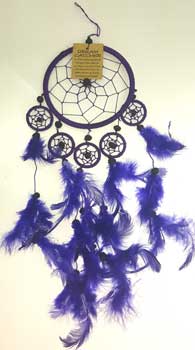Dreamcatcher Members Profile: Dreamcatcher Facts Dreamcatcher (드림캐쳐) consists of 7 members: JiU, SuA, Siyeon, Handong, Yoohyeon, Dami, and Gahyeon. Each member represents a nightmare or fear. The group debuted on January 13, 2017, under Happyface Entertainment. They are currently under Dreamcatcher Company. Dreamcatcher Fandom Name: InSomnia Dreamcatcher Official Fan Color: PANTONE. Native American Navajo Dream Catcher 3' -Purple (dc3-3) MSRP: $19.95 Sale Price: $12.95. This is an authentic Navajo dream catcher made with real deer. PINK PURPLE DREAM CATCHER WITH SHELLS 9 x 25cm BEDROOM NURSERY GIFT DREAMCATCER. $12.28 + shipping. 2020 Purple feather dream catcher feather wall hanging Nordic room decoration. DREAM CATCHER BLUE PURPLE VIOLET GIRLS KIDS GIFT NEW DREAMCATCHER DECORATION. Purple dreamcatcher car charm, small dream catcher for car, Rear view mirror charm hanger, Lavender nursery, Sun catchers, Gift for daughter VidaHandmadeUA From shop VidaHandmadeUA.
by K Shabi PUBLISHED 14 July 2016
What is the true meaning and history behind the Native American dreamcatcher? Where do dreamcatchers really come from? You've probably seen a dream catcher hanging from a tree, a porch or even in a souvenir gift shop and wondered about its purpose and meaning. Read on to learn more about the story, legend, and origins of authentic Native American dream catchers.

Authentic Native American Dream Catchers
Originally created by American Indians, dreamcatchers today come in a variety of different sizes and styles. They usually consist of a small wooden hoop covered in a net or web of natural fibers, with meaningful sacred items like feathers and beads attached, hanging down from the bottom of the hoop. Real authentic, traditional dream catchers are handmade and crafted only from all natural materials, in size measuring just a few small inches across. The hoop is traditionally constructed from a bent Red Willow branch covered in stretched sinews. Wrapping the frame in leather is another common finishing touch among 'real' dream catchers.
History of the Dreamcatcher: Ojibwe or Lakota Origins?
Today the dreamcatcher is associated with Native American culture in general, but dream catchers are often believed to have originated from the Ojibwa Chippewa tribe in particular. The Lakota tribe also has its own legend about the origins of the dreamcatcher, but most ethnographers believe the dreamcatchers were passed down from the Ojibwe through intermarriage and trade. The Ojibwe word for dreamcatcher asabikeshiinh actually means 'spider,' referring to the woven web loosely covering the hoop. The patterns of the dream catcher web are similar to the webbing these Native Americans also used for making snowshoes.
Ojibwa Legend: The story of the Dream catcher
Ancient legends about the history and origin of the dreamcatcher exist among several Native American tribes, but are most common and seem to originate among the Ojibwe and Lakota nations. While many cultures consider spiders to be creepy crawlers, the Ojibwe people saw them in a different light, as symbols of protection and comfort. According to an old Ojibwa legend, a mystical and maternal 'Spider Woman' once served as the spiritual protector for her tribe, especially in concern to young children, kids and babies. As the Ojibwe people flourished and spread out across the land, it was difficult for The Spider Woman to continue to protect and watch over all the members of the tribe as they migrated farther and farther away. This is why she created the first dreamcatcher. Following her example, over the course of generations mothers and grandmothers continued to ritualistically recreate the maternal keepsake as a means of mystically protecting their children and families even from a distance.
What do dream catchers do? Purpose & Meaning of the Dream Catcher
Sometimes referred to as 'Sacred Hoops,' Ojibwe dreamcatchers were traditionally used as talismans to protect sleeping people, usually children, from bad dreams and nightmares. This Native American tribe believes that the night air is filled with dreams, both good and bad. When hung above the bed in a place where the morning sunlight can hit it, the dream catcher attracts and catches all sorts of dreams and thoughts into its webs. Good dreams pass through and gently slide down the feathers to comfort the sleeper below. Bad dreams, however, are caught up in its protective net and destroyed, burned up in the light of day.
Purple Dream Catcher Amazon
Dream Catcher Meaning: Web, Feathers & Beads
All parts of the authentic Native American dreamcatcher have meaning tied to the natural world. The shape of the dreamcatcher is a circle because it represents the circle of life and how forces like the sun and moon travel each day and night across the sky. The dream catcher web catches the bad dreams during the night and dispose of them when the day comes. As for the good dreams, the feathers act as a fluffy, pillow-like ladder that allows them to gently descend upon the sleeping person undisturbed. There is some contention when it comes to the meaning of the beads that often decorate the dreamcatcher. According to some American Indians, the beads symbolize the spider—the web weaver itself. Others believe the beads symbolize the good dreams that could not pass through the web, immortalized in the form of sacred charms.
Dreamcatcher Meaning Today: Authentic Symbol or Cultural Appropriation?
Though dreamcatchers are quite common, finding real authentic dreamcatchers is not that easy today. Real handmade dream catchers are usually small in size and feature sacred charms like feathers and beads. Many dreamcatchers for sale today, however, are much more American than Native American, often oversized and constructed from cheap plastic materials. Many Native Americans still consider the dreamcatcher to be a long-standing cultural symbol of unity and identification among the many Indian Nations and First Nations cultures. Sadly, many other Native Americans have come to see dream catchers as just another cultural appropriation, over-commercialized and at times offensively misappropriated and misused by non-Natives.